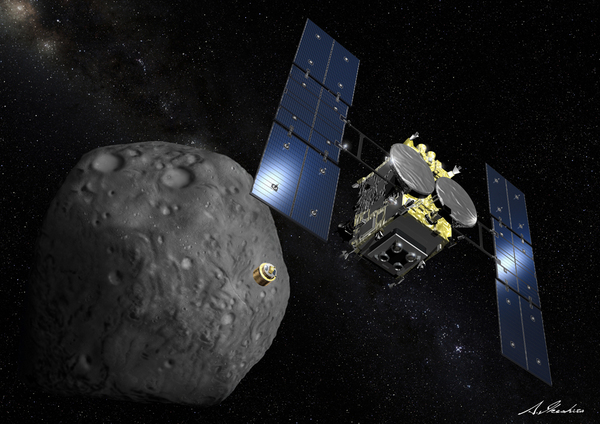ELSI Blog
141 A Martian geochemist's journey to the asteroids
 (Credit: JAXA/Akihiro Ikeshita)
(Credit: JAXA/Akihiro Ikeshita)
The arrival of the Hayabusa2 spacecraft to asteroid Ryugu (around the end of June 2018) is now close at hand. As of April 22, 2018, the distance to Ryugu was 234, 425 km and as I am writing this article, the gap is closing at a rate of 100m every second. [1]
Hayabusa2 is a mission to return to Earth a sample of an asteroid that is predicted to contain both water and organic matter. Many researchers believe that the water and organics that may be found in samples from Ryugu are the same as that which began life on Earth.
In this blog, I would like to describe how this writer --a geochemist-- became involved in asteroid exploration with Hayabusa2.
As someone who had been studying the history of Earth and Mars, the fact that asteroids only appeared as dots even through large telescopes did not make them very appealing! If not even their shape was well understood, how could this be an intriguing research subject?
In lectures on cosmo- and geo-chemistry [2], I taught a textbook-like description of asteroids, with statements such as "in Solar System formation theory, asteroids are the primitive (earliest) small bodies." Such explanations lacked tantalising questions or unexplained phenomenon that would make the area intriguing to a researcher. I wanted the challenge of explaining something tricky, and so I was drawn to Mars.
ELSI is engaged in research on the origin and evolution of water on Mars through examining Martian meteorites. Martian meteorites are rocks from the surface of Mars that have been ejected during a heavy bombardment of the red planet's surface by meteorites. Once they have escaped Mars's gravitational pull, they can fall to Earth. Through chemical analysis of the traces of water contained in the Martian meteorites, I began to believe that the seas that once covered Mars originated in asteroids similar to Ryugu [3]. Even though the ocean had now long disappeared, it seemed possible that large quantities of water might still be stored in rocks and ice beneath Mars's surface [4].
Then in January 2018, NASA's Mars orbiter, MRO, reported observations of previously underground ice that had been exposed during erosion [5]. Don't you find it exciting that there is still lots of ice buried beneath a desolate land that may have originated in distant asteroids? With this new evidence, Ryugu changed from being just a small rock to becoming the focus of my research.
I had begun to consider Ryugu as a celestial body with particular properties. Coincidentally and independently, Professor Watanabe from Nagoya University and Hayabusa2 project scientist, approached me with an epic proposal; "Let's not only consider Ryugu delivering water to Mars, but build a unified picture of how water arrived at the Earth, Mars, the icy moons and all other Solar System bodies."
After this, we began to study developing such a model with Dr Genda [6] and Dr Sekine [7] who are both associated researchers at ELSI. Since 2017, this led to the launch of a new research field: the birth of "aqua-planetology" [8].
In this framework of water and planetary science, Ryugu takes the role of a "custodian of the water and organics that were brought to the young Earth and Mars" and also that of a "laboratory demonstrating the type of chemical reactions that can occur with water and organics within such space rocks". Studying samples from Ryugu will therefore tell us about what compounds may be created in the first, small celestial bodies of the Solar System and what might have arrived on our planets and moons.
This means that in addition to the Hayabusa2 exploration team, members of the aqua-planetology team are now also keenly preparing for the arrival of Ryugu so their research can be complete. However, it is likely that the results will open the door to even more questions, so our research may never end!
[1] http://www.hayabusa2.jaxa.jp/
[2] http://www.ocw.titech.ac.jp/index.php?module=General&action=T0300&JWC=201701803&lang=EN
http://www.ocw.titech.ac.jp/index.php?module=General&action=T0300&JWC=201701803
[3] https://sites.google.com/site/marssciencet3/research/origin-of-water-on-mars
https://www.titech.ac.jp/news/2013/024237.html
[4] https://sites.google.com/site/marssciencet3/research/evidence-of-subsurface-water-on-mars
https://www.titech.ac.jp/news/2014/029417.html
[5] http://www.manyworlds.space/index.php/2018/01/11/the-mars-water-story-goes-deeper-and-wider/
[6] https://members.elsi.jp/~genda/
[7] http://www.astrobio.k.u-tokyo.ac.jp/sekine/
[8] http://www.aquaplanetology.jp/











